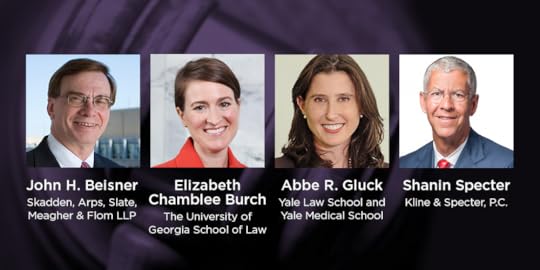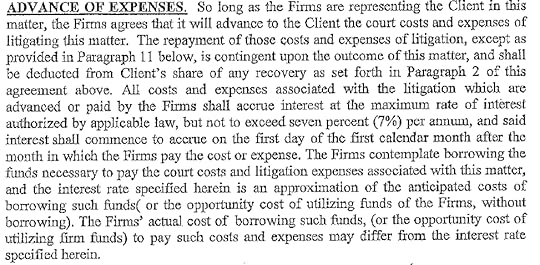Elizabeth Chamblee Burch's Blog
September 21, 2025
A Personal Curriculum for Understanding Justice in America
December 1, 2023
Purdue Pharma, the Sacklers, and the U.S. Supreme Court

Those of you who have been following the opioid lawsuits know that on Monday, December 4, 2023, the Supreme Court will hear oral arguments over whether to allow the billionaire Sackler family behind Purdue Pharma to glom on to Purdue's bankruptcy without declaring bankruptcy itself.
But do you know what's at stake for mass torts? Professors Abbe Gluck (Yale), Adam Zimmerman (USC Gould), and I explore that question in a new paper forthcoming in Yale Law Journal Forum. As we explain, the case provides a critical opportunity to reflect on what is lost when parties in mass torts find the “behemoth” litigation system unable to bring mass disputes to a close, when they charge multidistrict litigation as a “failure,” and when defendants contend that sprawling lawsuits across national courts have thrown them into unresolvable crisis that only bankruptcy can solve. Harrington v. Purdue Pharma L.P. is just one of many recent examples of extraordinarily unorthodox and creative civil procedure maneuvers—in both the bankruptcy and district courts—that push cases further away from the federal rules and the trial paradigm in the name of settlement.
Unlike ordinary state and federal trial courts, bankruptcy courts don’t generally lay blame for millions of deaths; they efficiently distribute resources. Petitioners in bankruptcy aren’t called “victims” or “plaintiffs”; they are “creditors” with limited voting rights over the distribution of an estate. Bankruptcy courts don’t develop state tort doctrines. They don’t engage in broad discovery designed to reveal accountability and spur policy reform. They rarely utilize juries or hear testimony from tort victims anxious to have their day in court; instead, testimony tends to focus on the debtor’s financial health.
Yet diverse defendants—many of whom, notably, are not even in financial distress—from Catholic Diocese and Boy Scout abuse cases, to Johnson & Johnson talc, 3M’s earplugs, Revlon hair straighteners, and many more, have now looked to the bankruptcy court to use its inherent authority to invent new forms of procedure to find a path to global peace. Bankruptcy courts are attractive in part because they possess some powers that, ironically, state and Article III federal courts do not—they are the only American courts that can overcome federalism’s jurisdictional boundaries; they are only courts with the power to commandeer both state and federal litigants into a single forum and halt all other civil litigation no matter what court it is in. They also have stretched their own equitable powers to allow innovative corporate maneuvers, as in Purdue, that cabin liability and preclude future litigation even for entities not in financial trouble. But bankruptcy court is not supposed to be a superpower of a court that trumps all others in public litigation; it is instead, an Article I court designed for efficient, private resolution of claims, centered on capturing private value for private actors–not the elaboration and development of law and public norms.
You can read more here if you're interested.
And if you're wanting to catch up on the issues before SCOTUS next week, check out Charlotte Bismuth & Jonathan Lipson's podcast, Bankruptcy for Billionaires, where the three of us talk about MDL, opioids, and bankruptcy. All credit goes to Charlotte and Jonathan for the great image at the top!
June 2, 2021
The Failed Roundup Gambit
Bayer and the plaintiffs’ lawyers suing it over its popular weed killer, Roundup, are playing a high-stakes, billion-dollar chess match. Like most corporate defendants in Bayer’s position, it wants lawsuits to end.
But finality eludes Bayer for two reasons.
First, non-Hodgkin’s lymphoma, the disease several juries linked to Roundup’s active ingredient glyphosate, doesn’t develop overnight. It takes a while, often 10-15 years after exposure. Yanking Roundup off the market today would still leave Bayer with at least another decade of litigation.
Second, Roundup makes Bayer lots of money. Sticking a warning label on it would hurt the company’s bottom line. Why would consumers risk cancer to kill dandelions?
Enter Bayer’s elaborate gambit.

Step one: preemption.
Bayer accurately predicted that the Ninth Circuit (despite a relatively conservative panel) would reject its argument that the Federal Insecticide, Fungicide, and Rodenticide Act, fondly known as FIFRA, preempts claims that it failed to warn weed exterminators about the risks of non-Hodgkin lymphoma. In May, the majority in Hardeman v. Bayer ruled that Mr. Hardeman’s failure-to-warn claim was “equivalent to” and “fully consistent with” FIFRA and thus not preempted under the Supreme Court’s 2005 precedent, Bates v. Dow Agrosciences LLC.
While it awaited the Hardeman decision, Bayer worked to manufacture a circuit split elsewhere that might tempt the Supreme Court to weigh in and reconsider Bates. For that, it tapped Dr. John Carson, a Georgia plaintiff who alleged a type of cancer that science has not linked to Roundup, malignant fibrous histiocytoma. Siding with Bayer, the Southern District of Georgia dismissed Dr. Carson’s failure-to-warn claim because FIFRA preempted it. Bayer won.
But that short-term win undermined its overarching goal. So, Bayer sacrificed by entering into a settlement of sorts with Dr. Carson: for $100,000, he would appeal the dismissal and the preemption ruling. Winning on preemption before the Eleventh Circuit would increase the likelihood of Supreme Court review, at least by a little, despite Bayer’s sly pay-to-appeal scheme.
The possibility of a circuit split and complete preemption serves another purpose, too. It acts like a sword of Damocles endangering plaintiffs who haven’t yet settled, haven’t yet sued, or haven’t yet developed non-Hodgkin lymphoma despite using Roundup. Plaintiffs won all three jury trials to date, notwithstanding a bifurcated trial structure that tends to favor defendants. Compared with the mature asbestos cases that led to the derailed Amchem settlement, the Roundup suits are barely entering grade school. But plaintiffs’ fortunes can turn.
Step two: certify a futures class.
Pressing the slimmest of advantages (after all, the Supreme Court grants certiorari in only around 3.4% of civil cases per year), Bayer teamed up with the same amenable plaintiffs’ counsel whose attempt at certifying a futures class last summer ended in a swirl of controversy and a withdrawn motion. Presenting a second, then a third futures class proposal, they purport to shelter three groups of class members from preemption’s peril:
(1) people diagnosed with non-Hodgkin lymphoma after Roundup exposure that haven’t hired lawyers yet;
(2) people who have used Roundup but haven’t yet developed non-Hodgkin lymphoma, and
(3) all of their spouses, parents, and dependent children—collectively, the “derivative claimants.”
But the preemption refuge and the benefits last a mere four years. And they come at a steep price. In exchange for notice, medical help, and some streamlined compensation, class members must give up punitive damages and medical monitoring claims, as well as bind themselves (with little wiggle room) to a seven-member science panel’s verdict about whether glyphosate can cause non-Hodgkin lymphoma.
After the four-year détente lifts, few plaintiff’s lawyers would litigate Roundup claims in the face of such weighty impediments.
For the gambit to work, the judge must certify the class. But Judge Vince Chhabria is no pawn and he declined to do so. His brief six-page opinion followed a day-long hearing transparently livestreamed in Brady-bunch boxes for a clamoring public to see.
In both the hearing and the opinion, Judge Chhabria challenged the settlement’s upside: Four years of medical monitoring for a disease with a 10-15 year latency period is “far less meaningful than the attorneys suggest.” Those with later diagnoses “will not be able to request compensation from the fund,” he wrote.
As Judge Chhabria pointed out, problems with the proposed futures class abound, including, most centrally, the constitutionality and utility of notice and the hamstrung tort claims. For plaintiffs, the downsides require “major sacrifices,” he explained.
First, on notice, what value does the settlement add that a well-incentivized plaintiffs’ bar lacks? The proposal allocates up to $55 million for settlement administration and notice costs for five months. Yet, over two years ago, the Wall Street Journal reported that plaintiffs’ lawyers spent an estimated $77.8 million to advertise Roundup lawsuits for eight months.
Setting aside the constitutional impossibilities of notifying future spouses and unborn children, what people need is meaningful information at a meaningful time. Noise fills the world. Our bandwidth is limited.
A Roundup user without cancer is far more likely to mindlessly scroll through whatever notices pop up than to engage and investigate. Someone newly diagnosed with non-Hodgkin lymphoma, however, is hungrily Googling for information and answers.
Second, consider what plaintiffs bestow upon Bayer by giving up punitive damages—absolution. But the alleged bad behavior continues. Imagine fining attempted murderers and freeing them to continue their spree. Roundup still lines store shelves and if it does what plaintiffs contend, it will endanger public health for decades to come.
First published in Westlaw Today on 6/2/2021
December 3, 2020
Last Chance to Tell Your Story: How'd your lawsuit go? What was MDL like?

How'd your lawsuit go? If you're a plaintiff in a women's health related mass tort like #mesh, #Mirena, #PowerMorcellator, #NuvaRing, #talc, etc. please take a few minutes to confidentially share your experience with the justice system.
The study will close on December 15, 2020. If you haven't had a chance to participate and would like to, I would love to hear from you. I designed the study to give plaintiffs suing over women's health mass torts a chance to voice their experiences--good and bad--with the courts.

If you have participated or are an attorney with clients in these proceedings, would you mind helping me spread the word?
Participants' identifying information will be kept completely confidential and if you'd rather not include your name on your response, you're welcome to let me know separately (masstortsuga@gmail.com).
For those of you who have taken the time to participate and who have reached out to me, I am not sure that simply saying "thank you" could ever convey the depth of my gratitude to each of you. It is easy for those of us who teach and no longer practice law to lose sight of the critical human element behind every lawsuit. Talking with some of you has truly changed me, changed my perspective, broadened my view of justice, and deepened my commitment to fix the issues that so many of you have encountered. So, though it will never be enough, thank you for opening my eyes and for sharing your time, your stories, and your struggles with me.
Take the survey.
Or learn more about it.
November 30, 2020
What is MDL?
Until they receive a notice that they have a case that has been transferred to a "MDL," even most lawyers have never heard of multidistrict litigation. So, if you're a lawyer or one of the many plaintiffs with a case that has been centralized through the MDL process, there's a lot to learn.
Through the American Law Institute's podcast, Reasonably Speaking, I had the opportunity to interview Yale Law and Yale Medical School Professor Abbe Gluck, defense attorney John Beisner of Skadden Arps, and plaintiff's attorney Shanin Specter of Kline & Specter.
We explore the basics of MDL as well as today's hot topics and current events: opioids, appeals, pelvic mesh, common benefit fees, and everything in between. We'd love for you to tune in! You can listen on Spotify, Apple, Google, Soundcloud, Stitcher, and Tunein here. That link will also take you to a wealth of free resources on those topics.

Or, if you'd prefer to watch the video, you can do so below.
https://vimeo.com/485599533
Last Call: Women's Health Procedural Justice Study

The perception of justice study that I've been working on since December of 2018 will close on December 15, 2020. If you haven't had a chance to participate and would like to, I would love to hear from you. I designed the study to give plaintiffs suing over women's health mass torts like pelvic mesh, Mirena, Mentor ObTape, Ortho Evra, talcum powder, Power Morcellator, and NuvaRing a chance to share their experiences with the courts (confidentially).
If you have participated or are an attorney with clients in these proceedings, would you mind helping me spread the word? Participants' identifying information will be kept completely confidential and if you'd rather not include your name on your response, you're welcome to let me know separately (masstortsuga@gmail.com).
For those of you who have taken the time to participate and who have reached out to me, I am not sure that simply saying "thank you" could ever convey the depth of my gratitude to each of you. It is easy for those of us who teach and no longer practice law to lose sight of the critical human element behind every lawsuit. Talking with some of you has truly changed me, changed my perspective, broadened my view of justice, and deepened my commitment to fix the issues that so many of you have encountered. So, though it will never be enough, thank you for opening my eyes and for sharing your time, your stories, and your struggles with me.
Take the survey.
October 16, 2020
Top 5 Eyebrow-Raising Provisions in Mesh Attorneys' Retainer Agreements

If you’re a plaintiff in a mass tort case like those involving pelvic and hernia mesh or talcum powder, chances are you’ve signed up with a law firm. Signing up with a law firm means signing a retainer agreement or a “fee agreement,” as they are sometimes called.
Retainer agreements spell out the law firm’s obligations to you and the fees and costs that you will incur as part of having that firm represent you. But signing on the dotted line doesn’t mean that clients actually understand what they're agreeing to—nor does it signal that the agreement itself is reasonable.
Fee agreements aren’t secret or confidential, but they are hard to find. I’ve unearthed a few agreements that are publicly available via court filings. Here are the top 5 eyebrow-raising provisions I found in those retainer agreements--all from the mesh litigation:
1. Contingent fee amount.
Ethical rules in most states require lawyers to charge only “reasonable fees,” and some states, like New York, limit the percentage that attorneys can charge to one-third, or 33.3%. The provision below charges the client a whopping 40% even if the lawyer never files a lawsuit and 45% thereafter.
 2. Common-benefit fees.
2. Common-benefit fees. In mass torts, judges often appoint “lead lawyers.” These attorneys are supposed to work on behalf of not just their own clients, but all of the plaintiffs in the proceeding. To pay them, judges withhold a portion of a plaintiff's settlement proceeds. The withheld percentage can range from 3-15%.
Common-benefit fees should be deducted from the individual plaintiffs’ attorney's contingency fee (the 33.3%)--NOT heaped on TOP of that contingency fee as in the provision below. Plaintiffs whose cases are litigated in a multidistrict proceeding should be no worse off for having the judge appoint lead lawyers. So, a plaintiff who agrees to a 33.3% contingency, still pays 33.3%, it just means that her lawyer must share a portion of that 33.3% with the lead lawyers.
But in the excerpt below, the client had to pay a 45% contingent fee plus Judge Goodwin’s 5% court-ordered fee because of the retainer agreement, resulting in an eye-popping 50% contingent fee. This is fundamentally wrong and cuts against every theory of common-benefit fees that I’ve encountered.
 3. Charging Interest on Expenses.
3. Charging Interest on Expenses. Law firms pay a lot of money to develop a client’s case. They hire pricey experts to prove causation and they front more mundane expenses like civil filing fees and copying costs. But charging clients interest on those expenses like in the clause below is troubling. It means that the longer a case lingers in court (via a protracted MDL, for example), the more a client must pay for costs.
 4. Withdrawing from the Attorney-Client Relationship.
4. Withdrawing from the Attorney-Client Relationship. States’ ethics rules dictate when a lawyer can “fire” a client, or withdraw from the representation. Model Rule of Professional Conduct 1.16(b) allows a lawyer to withdraw for no reason at all only if doing so will have no material adverse effect on the client’s interest. Clauses like the one below, which allow counsel to withdraw at any time, attempt to circumvent the protections afforded by the ethics rules.
 5. Arbitration Provisions.
5. Arbitration Provisions. For years, plaintiffs’ attorneys have lambasted arbitration provisions—and rightly so. Arbitration provisions allow those with the upper hand in contract bargaining to send a dispute to arbitration and some even allow that party to pick the arbitrator (the person who decides the case, in other words). So, imagine my surprise when I found that plaintiffs’ attorneys are taking advantage of arbitration provisions and waiving plaintiffs’ rights to sue them collectively when it suits them.

 What can you do?
What can you do?I’m in the process of creating a database of retainer agreements and writing an article to bring overreaching provisions to judges' attention, but I need your help. Would you send me a copy of your retainer agreement? I will take out your name and all of your identifying information (or you may do so before sending me the contract). I need to see how common these provisions are and I would like to post redacted retainer agreements as a resource for those who are shopping for representation. My email address is: masstortsuga@gmail.com
I am also conducting a study on all multidistrict proceedings in which the defendant targeted or advertised its product or medical device to women. The project asks plaintiffs involved in these cases, which include pelvic mesh and talcum powder, to confidentially share their litigation experiences. If you fall into this category, I’d be grateful if you’d take a few minutes to fill out the survey.
Finally, I have a book coming out this June (Mass Tort Deals: Backroom Bargaining in Multidistrict Litigation) that includes data on all the product liability proceedings pending on the MDL docket as of May of 2013. You can read more about it here; it may be of interest to anyone who is a plaintiff in a mass tort case.



